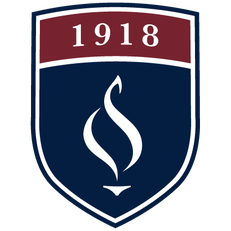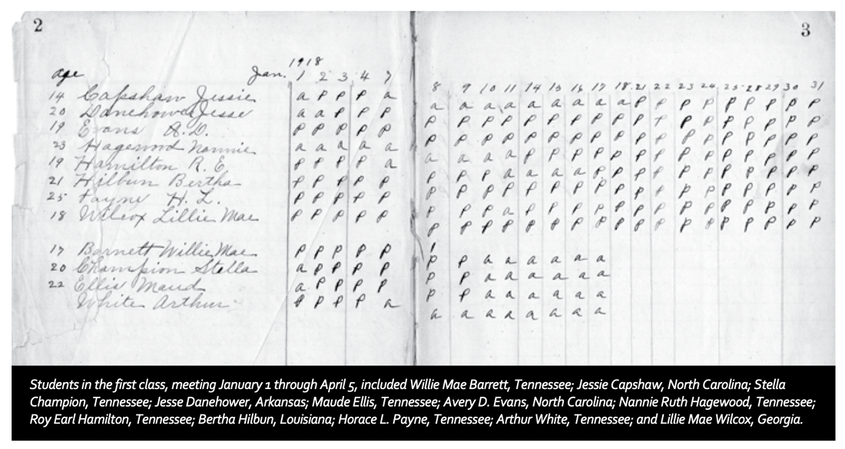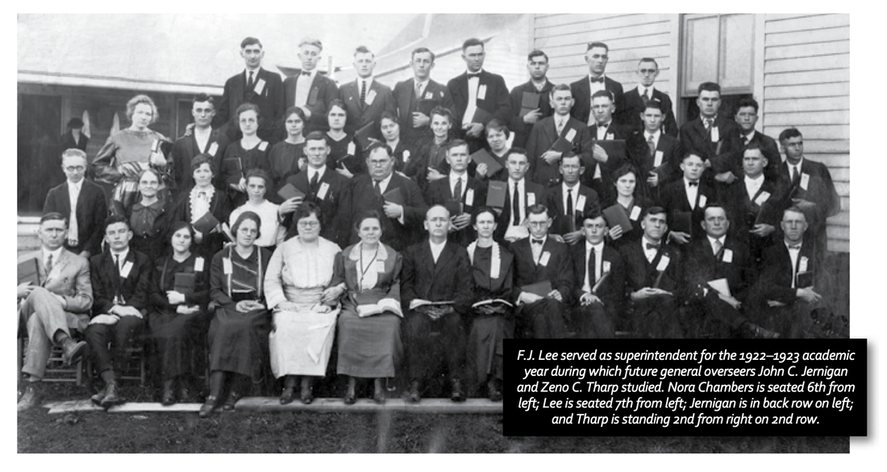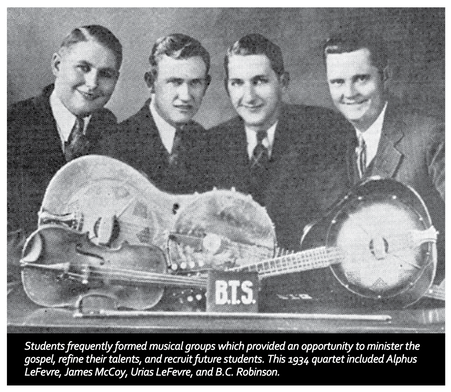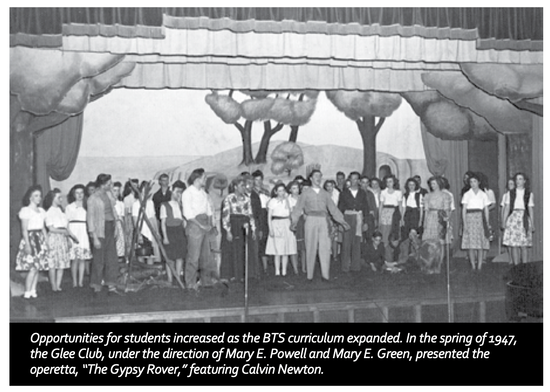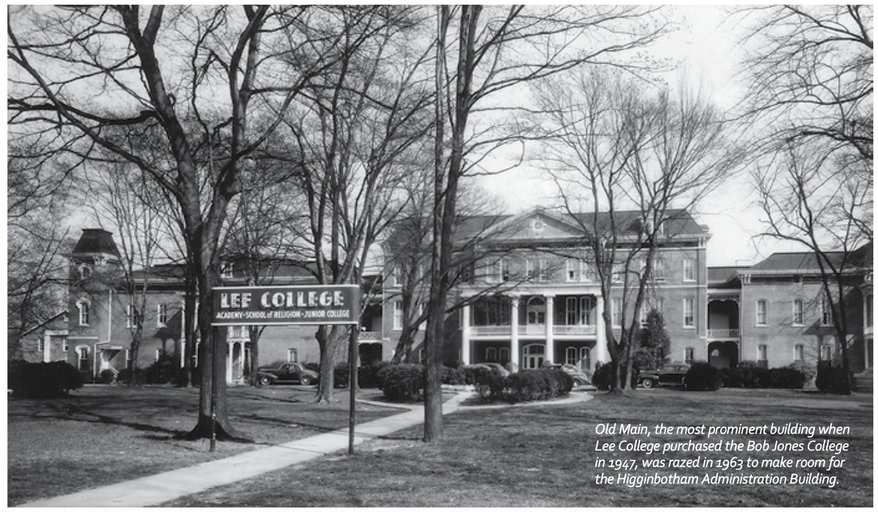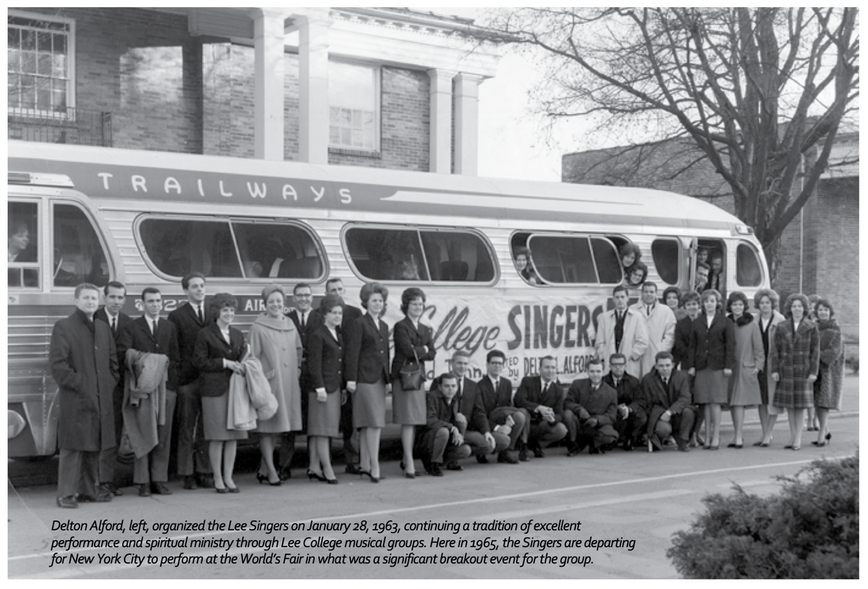Historical Overview of Lee University
Written by
Louis F. Morgan, Ph.D.
Lee University Historian
Louis F. Morgan, Ph.D.
Lee University Historian
Preparing for Christian Service: the Bible Training School
More than a century ago, the Church of God discerned the need for educational opportunities for ministerial development. Early church leaders recognized that, while eager to share the Gospel of Christ with others, many preachers had little training concerning the Scriptures. To meet this need, the Church of God established the Bible Training School.
At 9:30 on Tuesday morning, January 1, 1918, A. J. Tomlinson opened BTS in the upper room of Evangel Publishing Company at 2524 Gaut Street in Cleveland, Tennessee. The 600-square-foot space was the same room used for meetings of the Elders Council, now known as the International Executive Council. As general overseer, Tomlinson also served as superintendent for the school. Nora Chambers, a Church of God evangelist and copy editor at the publishing house, was the first teacher.
Chambers stated the objective of the school was “to train young men and women for Christian service.” To accomplish this, she taught from the Bible and Hurlbut’s Teacher-Training Lessons with additional instruction in Bible geography, spelling, English, and music. Tomlinson provided occasional lectures from the Book of Revelation.
There were 12 students that first term— seven females and five males from five states. They were carpenters, farmers, mothers, local church treasurers, musicians, evangelists, and even a former stage actress. Feeling called to ministry, they enrolled at BTS to learn more about the Bible and to become more effective pastors, evangelists, Sunday school teachers, and missionaries. Not all arrived by the first day of class, and only six remained at the end of the term in April. Tuition was one dollar per week.
Most out-of-town students lived across the street at the Tomlinson home, where Mary Jane Tomlinson provided motherly care and supervised meal preparation, while she tasked young Milton with setting the kitchen table. Alabama-student Arena Adair Blackwood, who arrived in 1920, remembered, “We all lived in A. J. Tomlinson’s home, since there were so few of us. Students were young and old alike; we were all [there] to learn more about God’s Word.” Conditions did not improve when students no longer lived in the Tomlinson home. Zeno C. Tharp, a student from Florida, explained, “…[T]he students had to room any place they could find. Often there were from four to ten in a room, and most of the time no baths or hot water were provided, and many times not even running water. Often the bedrooms were without heat.”
Despite limited resources, BTS proved to be transformative for those first students, such as Jesse Danehower from Haynes, Arkansas, who explained he enrolled “to get equipped with the good spiritual things coming from God…. In studying the Bible we are laying the foundation for the future in which we hope to obtain great victories.” He later reflected, “[W]e students and Sister Chambers spent many precious and happy hours reading, studying, praying, and shouting the high praise of God. These were some of the happiest hours of our lives.”
More than a century ago, the Church of God discerned the need for educational opportunities for ministerial development. Early church leaders recognized that, while eager to share the Gospel of Christ with others, many preachers had little training concerning the Scriptures. To meet this need, the Church of God established the Bible Training School.
At 9:30 on Tuesday morning, January 1, 1918, A. J. Tomlinson opened BTS in the upper room of Evangel Publishing Company at 2524 Gaut Street in Cleveland, Tennessee. The 600-square-foot space was the same room used for meetings of the Elders Council, now known as the International Executive Council. As general overseer, Tomlinson also served as superintendent for the school. Nora Chambers, a Church of God evangelist and copy editor at the publishing house, was the first teacher.
Chambers stated the objective of the school was “to train young men and women for Christian service.” To accomplish this, she taught from the Bible and Hurlbut’s Teacher-Training Lessons with additional instruction in Bible geography, spelling, English, and music. Tomlinson provided occasional lectures from the Book of Revelation.
There were 12 students that first term— seven females and five males from five states. They were carpenters, farmers, mothers, local church treasurers, musicians, evangelists, and even a former stage actress. Feeling called to ministry, they enrolled at BTS to learn more about the Bible and to become more effective pastors, evangelists, Sunday school teachers, and missionaries. Not all arrived by the first day of class, and only six remained at the end of the term in April. Tuition was one dollar per week.
Most out-of-town students lived across the street at the Tomlinson home, where Mary Jane Tomlinson provided motherly care and supervised meal preparation, while she tasked young Milton with setting the kitchen table. Alabama-student Arena Adair Blackwood, who arrived in 1920, remembered, “We all lived in A. J. Tomlinson’s home, since there were so few of us. Students were young and old alike; we were all [there] to learn more about God’s Word.” Conditions did not improve when students no longer lived in the Tomlinson home. Zeno C. Tharp, a student from Florida, explained, “…[T]he students had to room any place they could find. Often there were from four to ten in a room, and most of the time no baths or hot water were provided, and many times not even running water. Often the bedrooms were without heat.”
Despite limited resources, BTS proved to be transformative for those first students, such as Jesse Danehower from Haynes, Arkansas, who explained he enrolled “to get equipped with the good spiritual things coming from God…. In studying the Bible we are laying the foundation for the future in which we hope to obtain great victories.” He later reflected, “[W]e students and Sister Chambers spent many precious and happy hours reading, studying, praying, and shouting the high praise of God. These were some of the happiest hours of our lives.”
Overcoming Early Challenges
Those early years were filled with challenges. On more than one occasion, it seemed the school would close. When the second term began in November 1918, the Spanish Influenza was widespread. Several students were impacted, and influenza claimed the life of Bennie (Pettitt) Terrell, a 27-year-old homemaker and evangelist from Cartersville, Georgia. She began feeling ill in class and returned to her room at the Tomlinson home. A. J. Tomlinson remembered, “She gradually grew worse although prayers were offered up for her almost constantly day and night, and she was often quickened by the Spirit.” Bennie died two days before Christmas. Tomlinson reflected further, “During the time the Influenza epidemic has been raging, our home has been a veritable hospital excepting the use of medicine, having cared for twelve or more cases. Mrs. Tomlinson has been wonderfully preserved and sustained by the grace of God so she has never taken it. The Lord has had mercy upon us and shown us many unmerited favors in the midst of it all.”
Limited finances and space were other concerns. From the beginning, additional space was needed for classrooms and housing. In 1919 a three-story addition was built onto the publishing house. The following year, the school moved into North Cleveland Church’s former sanctuary. By 1925, the Bible school was sharing the Assembly Auditorium with North Cleveland Church, while the old sanctuary became a dormitory.
Realizing jobs and family responsibilities prohibited many from attending on campus, BTS initiated a correspondence course of 20 lessons for $40 in September 1919. It began with 203 students and increased to 788 the first year. Pearlie Ables, a local church treasurer and Sunday School teacher from Carbon Hill, Alabama, was the first to complete the course. Nora Chambers graded the lessons and supervised the program for several years.
Denominational tensions also affected the school. Tomlinson directly supervised church operations as general overseer. However, in 1922, the General Assembly delegated some responsibilities, and F. J. Lee became BTS superintendent. When the denomination divided a year later and a separate denomination emerged under Tomlinson’s leadership, BTS remained with the Church of God, but the financial strain created challenges. Nora Chambers noted, “It was a dark day when Brother Lee said the school would have to close. But we went to prayer and got our heads together to help answer our own prayers. Sister Lee gave her canned goods and bought no clothes that year. Sister Garner, the matron, did the cooking for no pay.” When Lee became general overseer in 1923, J. B. Ellis assumed leadership of the school for one year, followed by T. S. Payne from 1924-1930. By the grace of God and the ingenuity and willing sacrifices of the school’s early leaders and church members, BTS survived during a period of extreme financial difficulty.
Although times were challenging, students found a place of belonging and spiritual nurture. Mississippi-student Grant Williams enrolled in November 1918 and often reflected about Nora Chambers leading students in prayer and worship between their studies. Williams particularly remembered when several students were filled with the Holy Spirit as the class sang “O I Want to See Him.” Music was an important part of the school from the beginning, and students brought their own instruments, such as guitars, banjos, mandolins, saxophones, trombones, and accordions.
Those early years were filled with challenges. On more than one occasion, it seemed the school would close. When the second term began in November 1918, the Spanish Influenza was widespread. Several students were impacted, and influenza claimed the life of Bennie (Pettitt) Terrell, a 27-year-old homemaker and evangelist from Cartersville, Georgia. She began feeling ill in class and returned to her room at the Tomlinson home. A. J. Tomlinson remembered, “She gradually grew worse although prayers were offered up for her almost constantly day and night, and she was often quickened by the Spirit.” Bennie died two days before Christmas. Tomlinson reflected further, “During the time the Influenza epidemic has been raging, our home has been a veritable hospital excepting the use of medicine, having cared for twelve or more cases. Mrs. Tomlinson has been wonderfully preserved and sustained by the grace of God so she has never taken it. The Lord has had mercy upon us and shown us many unmerited favors in the midst of it all.”
Limited finances and space were other concerns. From the beginning, additional space was needed for classrooms and housing. In 1919 a three-story addition was built onto the publishing house. The following year, the school moved into North Cleveland Church’s former sanctuary. By 1925, the Bible school was sharing the Assembly Auditorium with North Cleveland Church, while the old sanctuary became a dormitory.
Realizing jobs and family responsibilities prohibited many from attending on campus, BTS initiated a correspondence course of 20 lessons for $40 in September 1919. It began with 203 students and increased to 788 the first year. Pearlie Ables, a local church treasurer and Sunday School teacher from Carbon Hill, Alabama, was the first to complete the course. Nora Chambers graded the lessons and supervised the program for several years.
Denominational tensions also affected the school. Tomlinson directly supervised church operations as general overseer. However, in 1922, the General Assembly delegated some responsibilities, and F. J. Lee became BTS superintendent. When the denomination divided a year later and a separate denomination emerged under Tomlinson’s leadership, BTS remained with the Church of God, but the financial strain created challenges. Nora Chambers noted, “It was a dark day when Brother Lee said the school would have to close. But we went to prayer and got our heads together to help answer our own prayers. Sister Lee gave her canned goods and bought no clothes that year. Sister Garner, the matron, did the cooking for no pay.” When Lee became general overseer in 1923, J. B. Ellis assumed leadership of the school for one year, followed by T. S. Payne from 1924-1930. By the grace of God and the ingenuity and willing sacrifices of the school’s early leaders and church members, BTS survived during a period of extreme financial difficulty.
Although times were challenging, students found a place of belonging and spiritual nurture. Mississippi-student Grant Williams enrolled in November 1918 and often reflected about Nora Chambers leading students in prayer and worship between their studies. Williams particularly remembered when several students were filled with the Holy Spirit as the class sang “O I Want to See Him.” Music was an important part of the school from the beginning, and students brought their own instruments, such as guitars, banjos, mandolins, saxophones, trombones, and accordions.
Expanding the Curriculum
While the 1920s were challenging, the 1930s brought expansion and advancement. 30-year-old J. H. Walker Sr. of Dunn, Louisiana, became superintendent in 1930. A BTS graduate, he also had taken courses at Louisiana Polytechnic Institute, evening classes at a business school, and received private music lessons. He immediately expanded the curriculum by adding two programs— Commercial/Business and Music— and hired teachers with advanced degrees and specialized training.
Walker was a progressive leader who understood students attended other schools for training beyond traditional ministerial vocations, and he believed those students also should have a Christ-centered environment in which to learn. The new programs paved the way for the school to become a stronger academic institution.
Walker hired Henrietta Ayer Green in 1930 to teach business courses. Trained at the Washington, D.C. School for Secretaries, she operated a business school at a local Cleveland hotel, where she was a bookkeeper. According to Green, “[BTS] didn’t have any typewriters so I had to carry five of mine from my school at the hotel to [BTS] and then back to the hotel every day.” She earned two dollars for each student she taught, and she was the school’s first full-time teacher from a denomination other than Church of God.
Also in 1930, BTS hired Otis L. McCoy of Addison, Alabama, to begin a formal music program, including evening classes that appealed to community residents. McCoy was a Church of God minister and gifted songwriter trained professionally at the James D. Vaughan Conservatory of Music. He began an orchestra and created courses in theory, sight singing and ear training, harmony, counterpoint, composition, music appreciation and history, and repertoire. He also taught private lessons in voice and led instruction on a variety of instruments. B. C. Robinson served as his fist teaching assistant before Owel Denson was hired to assist with instruction. McCoy and Denson previously taught together in singing schools using the Sacred Harp shaped-note tradition, which they incorporated into BTS courses. McCoy also promoted BTS by sending student trios, quartets, and small ensembles to local churches and state camp meetings. Many BTS students became household names in Gospel music, such as the LeFevre Trio, the Klaudt Indian Family Singers, and Bennie Triplett.
In 1932, BTS hired Cleveland-native Katherine Lowery [Trewhitt], the school’s first full-time teacher with a bachelor’s degree, to teach Latin and Greek. That same year a high school division was started. In those days, most pastors were appointed to new churches annually at the General Assembly or state conventions, and the brief tenures often made it difficult for their children to adjust in new schools. Sending their children to the Academy (high school) provided a more stable educational environment with a Christ-centered focus. Mildred Blackwell (who later served as a missionary with her husband, Hoyle Case) had an associate’s degree and teaching experience, and she began teaching the first high school courses.
The following year, R. R. Walker, the high school superintendent at Morgantown, Mississippi, was baptized with the Holy Spirit and united with the Church of God. A 1927 graduate of Mississippi College with a bachelor’s degree in education, BTS immediately secured him as principal for the Academy. He was the school’s first male teacher with a bachelor’s degree and the first Church of God minister with a bachelor’s degree. During his 10-year tenure, he also taught Bible classes and helped establish the junior college program.
While the 1920s were challenging, the 1930s brought expansion and advancement. 30-year-old J. H. Walker Sr. of Dunn, Louisiana, became superintendent in 1930. A BTS graduate, he also had taken courses at Louisiana Polytechnic Institute, evening classes at a business school, and received private music lessons. He immediately expanded the curriculum by adding two programs— Commercial/Business and Music— and hired teachers with advanced degrees and specialized training.
Walker was a progressive leader who understood students attended other schools for training beyond traditional ministerial vocations, and he believed those students also should have a Christ-centered environment in which to learn. The new programs paved the way for the school to become a stronger academic institution.
Walker hired Henrietta Ayer Green in 1930 to teach business courses. Trained at the Washington, D.C. School for Secretaries, she operated a business school at a local Cleveland hotel, where she was a bookkeeper. According to Green, “[BTS] didn’t have any typewriters so I had to carry five of mine from my school at the hotel to [BTS] and then back to the hotel every day.” She earned two dollars for each student she taught, and she was the school’s first full-time teacher from a denomination other than Church of God.
Also in 1930, BTS hired Otis L. McCoy of Addison, Alabama, to begin a formal music program, including evening classes that appealed to community residents. McCoy was a Church of God minister and gifted songwriter trained professionally at the James D. Vaughan Conservatory of Music. He began an orchestra and created courses in theory, sight singing and ear training, harmony, counterpoint, composition, music appreciation and history, and repertoire. He also taught private lessons in voice and led instruction on a variety of instruments. B. C. Robinson served as his fist teaching assistant before Owel Denson was hired to assist with instruction. McCoy and Denson previously taught together in singing schools using the Sacred Harp shaped-note tradition, which they incorporated into BTS courses. McCoy also promoted BTS by sending student trios, quartets, and small ensembles to local churches and state camp meetings. Many BTS students became household names in Gospel music, such as the LeFevre Trio, the Klaudt Indian Family Singers, and Bennie Triplett.
In 1932, BTS hired Cleveland-native Katherine Lowery [Trewhitt], the school’s first full-time teacher with a bachelor’s degree, to teach Latin and Greek. That same year a high school division was started. In those days, most pastors were appointed to new churches annually at the General Assembly or state conventions, and the brief tenures often made it difficult for their children to adjust in new schools. Sending their children to the Academy (high school) provided a more stable educational environment with a Christ-centered focus. Mildred Blackwell (who later served as a missionary with her husband, Hoyle Case) had an associate’s degree and teaching experience, and she began teaching the first high school courses.
The following year, R. R. Walker, the high school superintendent at Morgantown, Mississippi, was baptized with the Holy Spirit and united with the Church of God. A 1927 graduate of Mississippi College with a bachelor’s degree in education, BTS immediately secured him as principal for the Academy. He was the school’s first male teacher with a bachelor’s degree and the first Church of God minister with a bachelor’s degree. During his 10-year tenure, he also taught Bible classes and helped establish the junior college program.
BTS Becomes a College
Enrollment continued to increase, and space became limited. In 1938, BTS relocated to Sevierville, Tennessee, to the former Murphy Collegiate Institute campus, which offered room to expand. At Sevierville, with Zeno C. Tharp as president, BTS made some of its most important advancements.
Tharp already was a significant leader in the Church of God and had received training at Holmes Bible School when he became superintendent in 1935. During his presidency, BTS experienced gains in income and enrollment, increasing from 157 students in 1937 to 600 students in 1942. He led in restructuring the school, hiring more degreed teachers, and increasing the school term to nine months. Many students became significant ministry leaders globally.
Perhaps the most notable advancements were the initial accreditation of the Academy and the beginning of a two-year junior college. The Academy had helped create the need for the junior college, as many students who completed high school desired to attend college, but in programs other than those offered at BTS. The junior college expanded curriculum options and provided training that was Christian in spirit while broad in cultural emphasis. The school was renamed “Bible Training School and College” in 1941.
School and denominational officials understood the importance of attaining accreditation to meet the academic demands of a quality education. To help reach this goal, progressive administrators were hired, including Mary Elizabeth Harrison Green and Earl M. Tapley. Tharp recruited Green in 1942 as principal of the Academy, and she was the first administrator with a Master’s degree. When E. L. Simmons became president in 1945, he recruited Tapley, a BTS graduate and progressive pastor with a Master’s degree. Hired in 1946, Tapley was the school’s first vice president and briefly served as acting president in 1951.
Soon after Simmons became president, BTS purchased the 20-acre campus of Bob Jones College in Cleveland for $1.5 million and announced it would relocate. That campus had served as an educational center since 1885 with the establishment of Centenary Women’s College.
Returning to Cleveland marked a significant transition, and enrollment indicated the junior college was its future. Vice President Tapley saw this as an opportunity to focus on that future and suggested changing the name to Lee College, in honor of its early leader, F. J. Lee. President Simmons proposed the idea to the Board of Directors, who approved.
The future was promising for this college that had begun 29 years earlier as a hopeful endeavor with one teacher and a dozen students. The years in Sevierville were productive and afforded the school time to develop its own identity. While expanding beyond its initial curriculum, the school remained committed to its original mission of preparing young men and women for Christian service and providing them with a Christ-centered education. With the return to Cleveland, there again was hopeful anticipation for its potential as an emerging academic institution.
Enrollment continued to increase, and space became limited. In 1938, BTS relocated to Sevierville, Tennessee, to the former Murphy Collegiate Institute campus, which offered room to expand. At Sevierville, with Zeno C. Tharp as president, BTS made some of its most important advancements.
Tharp already was a significant leader in the Church of God and had received training at Holmes Bible School when he became superintendent in 1935. During his presidency, BTS experienced gains in income and enrollment, increasing from 157 students in 1937 to 600 students in 1942. He led in restructuring the school, hiring more degreed teachers, and increasing the school term to nine months. Many students became significant ministry leaders globally.
Perhaps the most notable advancements were the initial accreditation of the Academy and the beginning of a two-year junior college. The Academy had helped create the need for the junior college, as many students who completed high school desired to attend college, but in programs other than those offered at BTS. The junior college expanded curriculum options and provided training that was Christian in spirit while broad in cultural emphasis. The school was renamed “Bible Training School and College” in 1941.
School and denominational officials understood the importance of attaining accreditation to meet the academic demands of a quality education. To help reach this goal, progressive administrators were hired, including Mary Elizabeth Harrison Green and Earl M. Tapley. Tharp recruited Green in 1942 as principal of the Academy, and she was the first administrator with a Master’s degree. When E. L. Simmons became president in 1945, he recruited Tapley, a BTS graduate and progressive pastor with a Master’s degree. Hired in 1946, Tapley was the school’s first vice president and briefly served as acting president in 1951.
Soon after Simmons became president, BTS purchased the 20-acre campus of Bob Jones College in Cleveland for $1.5 million and announced it would relocate. That campus had served as an educational center since 1885 with the establishment of Centenary Women’s College.
Returning to Cleveland marked a significant transition, and enrollment indicated the junior college was its future. Vice President Tapley saw this as an opportunity to focus on that future and suggested changing the name to Lee College, in honor of its early leader, F. J. Lee. President Simmons proposed the idea to the Board of Directors, who approved.
The future was promising for this college that had begun 29 years earlier as a hopeful endeavor with one teacher and a dozen students. The years in Sevierville were productive and afforded the school time to develop its own identity. While expanding beyond its initial curriculum, the school remained committed to its original mission of preparing young men and women for Christian service and providing them with a Christ-centered education. With the return to Cleveland, there again was hopeful anticipation for its potential as an emerging academic institution.
A New Beginning
When the Church of God’s flagship educational institution returned to Cleveland in 1947, more than 600 students enrolled in one of three divisions: Junior College, Academy (high school), or Religious Education. Those first years as Lee College were marked with advancement, and enrollment in the Junior College surpassed that of the original religious education program. J. Stewart Brinsfield became Lee’s president in 1948, and his leadership, accompanied by an administrative team of visionaries, accelerated Lee’s development.
The shift toward a more academic curriculum was not without tension, however. Opinions varied as to Lee’s future. As historian Charles W. Conn explained, “Some felt that it should be a liberal arts college with strong curricula in theology and biblical studies, while others felt that it should be strictly a Bible College for training Christian workers, with only necessary courses in arts and sciences. The question to identify virtually ended the excitement and growth. A decade would pass before that matter was finally settled.”
As an effort to strengthen the biblical training emphasis, in 1953 the school began Lee Bible College, a four-year degree program which received accreditation from American Association of Theological Schools in 1959. Nonetheless, the continued tension over Lee’s approach to education contributed to a rapid turnover in leadership, including four presidents in 10 years: J. Stewart Brinsfield (1948–1951), John C. Jernigan (1951–1952), R. Leonard Carroll Sr. (1952–1957), and Rufus L. Platt (1957–1960). Lee found it difficult to retain faculty, and student enrollment declined to less than 400 by 1959.
Ray H. Hughes became president in 1960, having attended BTS and establishing himself as a Church of God leader. His guidance in creating new programs and connecting with alumni and potential students led to growth. In 1960, the Southern Association also accredited the two-year Junior College, a significant accomplishment and affirmation of Lee’s direction.
Response to Changing Times
The 1960s marked a period of rapid change and cultural shifts. While the transition was met with student riots at many colleges, the changes at Lee, although slow at times, were peaceful. A significant advancement was Lee’s desegregation. In the early years, the school adhered to government laws prohibiting integrated schools, except for a handful of minority students with missions-related status, whom the school had accepted since 1928. In the 1950s and 1960s, Lee provided teachers for music and Bible classes for the denomination’s underserved minority constituency. In May 1964, the Church of God adopted a resolution endorsing the desegregation of schools. Two years later, Lee was desegregated when Deborah Bacon and Larry Cox of Cleveland and Hazel Edwards of Mississippi became the first African-American students. Mollye Edmond of Mississippi, Pauline Washington of Washington, D. C., Mike Linley of Georgia, and Sam Ellis and Quan Miller of Florida soon joined them.
When the Church of God’s flagship educational institution returned to Cleveland in 1947, more than 600 students enrolled in one of three divisions: Junior College, Academy (high school), or Religious Education. Those first years as Lee College were marked with advancement, and enrollment in the Junior College surpassed that of the original religious education program. J. Stewart Brinsfield became Lee’s president in 1948, and his leadership, accompanied by an administrative team of visionaries, accelerated Lee’s development.
The shift toward a more academic curriculum was not without tension, however. Opinions varied as to Lee’s future. As historian Charles W. Conn explained, “Some felt that it should be a liberal arts college with strong curricula in theology and biblical studies, while others felt that it should be strictly a Bible College for training Christian workers, with only necessary courses in arts and sciences. The question to identify virtually ended the excitement and growth. A decade would pass before that matter was finally settled.”
As an effort to strengthen the biblical training emphasis, in 1953 the school began Lee Bible College, a four-year degree program which received accreditation from American Association of Theological Schools in 1959. Nonetheless, the continued tension over Lee’s approach to education contributed to a rapid turnover in leadership, including four presidents in 10 years: J. Stewart Brinsfield (1948–1951), John C. Jernigan (1951–1952), R. Leonard Carroll Sr. (1952–1957), and Rufus L. Platt (1957–1960). Lee found it difficult to retain faculty, and student enrollment declined to less than 400 by 1959.
Ray H. Hughes became president in 1960, having attended BTS and establishing himself as a Church of God leader. His guidance in creating new programs and connecting with alumni and potential students led to growth. In 1960, the Southern Association also accredited the two-year Junior College, a significant accomplishment and affirmation of Lee’s direction.
Response to Changing Times
The 1960s marked a period of rapid change and cultural shifts. While the transition was met with student riots at many colleges, the changes at Lee, although slow at times, were peaceful. A significant advancement was Lee’s desegregation. In the early years, the school adhered to government laws prohibiting integrated schools, except for a handful of minority students with missions-related status, whom the school had accepted since 1928. In the 1950s and 1960s, Lee provided teachers for music and Bible classes for the denomination’s underserved minority constituency. In May 1964, the Church of God adopted a resolution endorsing the desegregation of schools. Two years later, Lee was desegregated when Deborah Bacon and Larry Cox of Cleveland and Hazel Edwards of Mississippi became the first African-American students. Mollye Edmond of Mississippi, Pauline Washington of Washington, D. C., Mike Linley of Georgia, and Sam Ellis and Quan Miller of Florida soon joined them.
Creating a Unique Identity
Several student life programs began in the 1960s and 1970s that helped shape Lee’s identity and provided a sense of community. The first Greek-letter social service clubs were chartered: Upsilon Xi (1962) and Alpha Gamma Chi (1963) for men, and Delta Zeta Tau (1964) and Sigma Nu Sigma (1966) for women. Today students can participate in 10 Greek-letter service clubs and numerous other academic and social clubs. Parade of Favorites began in 1963 with Betty Jo Byrd [Sumner] of Lakeland, Florida, chosen as the first “Miss POF.” Emerging from the first traveling choir, organized in 1958 by A.T. Humphries, vocal and instrumental ensembles represented Lee across the nation and internationally. Currently, these include Campus Choir, Evangelistic Singers, Ladies of Lee, Lee Singers, Voices of Lee, and Symphonic Band.
Intramural athletic teams have existed at Lee since the 1940s, but the first varsity team, men’s basketball, was organized in 1958 with Hubert Black as athletic director. Lee adopted the Vikings mascot by 1961, but transitioned to the Flames in 1982. Today, more than 10 athletic varsity teams compete in the NCAA Division II – Gulf South Conference, and Lee’s student athletes have earned recognition for their excellence on the field and in the classroom.
These new initiatives created enthusiasm among prospective students, and by 1966 enrollment exceeded 1,000 for the first time.
The Dream Becomes a Reality
The period of decline at Lee in the 1950s caused church leadership to reconsider its approach to higher education. They appointed a committee comprised of James A. Cross, Charles W. Conn, Ray H. Hughes, James L. Slay, and Lewis Willis in 1960 to better comprehend the future needs in higher education. Two years later, they recommended, “…it is our responsibility to sponsor one four-year liberal arts college, strong in education and the arts. It is our further responsibility to sponsor a strong school of theology and Christian training. We recommend that our efforts and attention be directed toward the full realization of such an institution, which is and shall be Lee College.” This was a significant turning point for Church of God higher education and for Lee.
In 1966, James A. Cross became president, and Donald Aultman was hired as vice president and dean. Lee’s academic development continued with the addition of faculty with doctorates and credentials necessary to meet accreditation standards and provide quality instruction to students.
Following the recommendation of the Executive Council and Lee’s Board of Directors to unify the academic programs, the Academy closed in 1965. Three years later, Lee Bible College and the Liberal Arts program merged, allowing the school to focus more intently on a four-year degree program. Lee became a unified college with three divisions: Arts and Sciences, Religion, and Teacher Education. Aultman later reflected: “We had to take an academic bulldozer, turn the college upside down, and completely redesign it…. We created vehicles for student involvement in governance—college council, faculty affairs, [and] curriculum. We acquired doctoral faculty for each major area of study…. We raised faculty wages and established a tenure policy…. The changes we imposed on the college were not perfect, but crucial, fearless adjustments that led to Southern Association of Colleges and Schools accreditation.” The accreditation was awarded in December 1969.
After Lee College received accreditation, Charles W. Conn was selected as president in 1970 following his tenure as general overseer. An esteemed Church of God leader who also appreciated the arts and literature, he guided Lee’s transition into a four-year liberal arts college while maintaining its Christ-centered mission. Lee increased student services, strengthened academics, and intentionally provided broader cultural opportunities for students. Additionally, Lee welcomed community residents to campus for cultural and worship events. Conn served 12 years and is the only person to date named President Emeritus.
Enrollment continued to increase, reaching 1,342 students in 1979, before an economic recession created challenges and led to a decrease. Ray H. Hughes was appointed president a second time in 1982. R. Lamar Vest became president two years later and secured psychology faculty member Paul Conn as vice president for Institutional Advancement. Enrollment had dipped to 960, but Vest and Conn worked together to strengthen the college financially, numerically, and academically. Within two years, enrollment increased to 1,214 students.
Several student life programs began in the 1960s and 1970s that helped shape Lee’s identity and provided a sense of community. The first Greek-letter social service clubs were chartered: Upsilon Xi (1962) and Alpha Gamma Chi (1963) for men, and Delta Zeta Tau (1964) and Sigma Nu Sigma (1966) for women. Today students can participate in 10 Greek-letter service clubs and numerous other academic and social clubs. Parade of Favorites began in 1963 with Betty Jo Byrd [Sumner] of Lakeland, Florida, chosen as the first “Miss POF.” Emerging from the first traveling choir, organized in 1958 by A.T. Humphries, vocal and instrumental ensembles represented Lee across the nation and internationally. Currently, these include Campus Choir, Evangelistic Singers, Ladies of Lee, Lee Singers, Voices of Lee, and Symphonic Band.
Intramural athletic teams have existed at Lee since the 1940s, but the first varsity team, men’s basketball, was organized in 1958 with Hubert Black as athletic director. Lee adopted the Vikings mascot by 1961, but transitioned to the Flames in 1982. Today, more than 10 athletic varsity teams compete in the NCAA Division II – Gulf South Conference, and Lee’s student athletes have earned recognition for their excellence on the field and in the classroom.
These new initiatives created enthusiasm among prospective students, and by 1966 enrollment exceeded 1,000 for the first time.
The Dream Becomes a Reality
The period of decline at Lee in the 1950s caused church leadership to reconsider its approach to higher education. They appointed a committee comprised of James A. Cross, Charles W. Conn, Ray H. Hughes, James L. Slay, and Lewis Willis in 1960 to better comprehend the future needs in higher education. Two years later, they recommended, “…it is our responsibility to sponsor one four-year liberal arts college, strong in education and the arts. It is our further responsibility to sponsor a strong school of theology and Christian training. We recommend that our efforts and attention be directed toward the full realization of such an institution, which is and shall be Lee College.” This was a significant turning point for Church of God higher education and for Lee.
In 1966, James A. Cross became president, and Donald Aultman was hired as vice president and dean. Lee’s academic development continued with the addition of faculty with doctorates and credentials necessary to meet accreditation standards and provide quality instruction to students.
Following the recommendation of the Executive Council and Lee’s Board of Directors to unify the academic programs, the Academy closed in 1965. Three years later, Lee Bible College and the Liberal Arts program merged, allowing the school to focus more intently on a four-year degree program. Lee became a unified college with three divisions: Arts and Sciences, Religion, and Teacher Education. Aultman later reflected: “We had to take an academic bulldozer, turn the college upside down, and completely redesign it…. We created vehicles for student involvement in governance—college council, faculty affairs, [and] curriculum. We acquired doctoral faculty for each major area of study…. We raised faculty wages and established a tenure policy…. The changes we imposed on the college were not perfect, but crucial, fearless adjustments that led to Southern Association of Colleges and Schools accreditation.” The accreditation was awarded in December 1969.
After Lee College received accreditation, Charles W. Conn was selected as president in 1970 following his tenure as general overseer. An esteemed Church of God leader who also appreciated the arts and literature, he guided Lee’s transition into a four-year liberal arts college while maintaining its Christ-centered mission. Lee increased student services, strengthened academics, and intentionally provided broader cultural opportunities for students. Additionally, Lee welcomed community residents to campus for cultural and worship events. Conn served 12 years and is the only person to date named President Emeritus.
Enrollment continued to increase, reaching 1,342 students in 1979, before an economic recession created challenges and led to a decrease. Ray H. Hughes was appointed president a second time in 1982. R. Lamar Vest became president two years later and secured psychology faculty member Paul Conn as vice president for Institutional Advancement. Enrollment had dipped to 960, but Vest and Conn worked together to strengthen the college financially, numerically, and academically. Within two years, enrollment increased to 1,214 students.
Lee Becomes a University
Paul Conn became president in 1986. He began his presidency at age 40 with hopeful vision, a love for Lee, and contagious enthusiasm that renewed excitement about Lee’s future. He assembled an energetic team committed to Christ-centered, student-focused academic excellence. During his inaugural address, he proclaimed: “We are trying to teach
Paul Conn became president in 1986. He began his presidency at age 40 with hopeful vision, a love for Lee, and contagious enthusiasm that renewed excitement about Lee’s future. He assembled an energetic team committed to Christ-centered, student-focused academic excellence. During his inaugural address, he proclaimed: “We are trying to teach
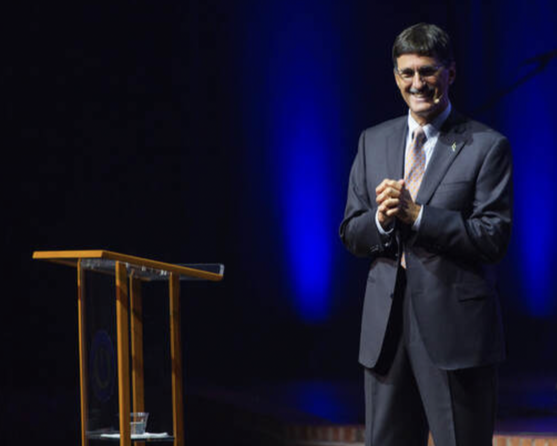
[students] that the greatest force in human history is produced by the fusion of man’s ability with God’s power. We want them to understand that the ultimate expression of the human experience is to train and prepare oneself with discipline and hard work, and then to submit oneself to the sovereignty of God to do as He wills with us. I want to teach them that the greatest power in the world is unleashed when the enormous energy of the human spirit is undergirded, channeled, and empowered by the hand of Almighty God.”
Within two years, Lee reached an enrollment of more than 1,500 students. Building projects began that would span 30 years of expansion in order to keep up with enrollment and the development of new academic programs. Lee offered its first graduate courses in 1995, and two years later, awarded its first degrees in the Master of Church Music.
On May 10, 1997, Lee adopted a university structure and now offers almost 100 major fields of study (undergraduate, graduate, and education specialist) in six schools: College of Arts and Sciences, College of Education, School of Business, School of Music, School of Nursing, and School of Religion. Lee also enjoys partnerships with the European Theological Seminary in Germany, and offers graduate programs at SEMISUD in Ecuador and SEBIPCA in Guatemala. Lee University sets the standard for the certification of postsecondary schools in the Church of God.
By its Centennial year in 2018, Lee University had become known as a respected, Christ-centered academic institution with more than 5,300 students (on campus and online) from 52 countries. It continues to expand its academic programs, build state-of-the-art facilities across its 120-acres, and attract a well-trained faculty and staff. Lee has nationally ranked athletic teams, a vigorous global cross-cultural program, a nationally recognized service-learning program, and a continually growing list of internationally recognized musical talent. Lee’s faculty, staff, and administrators provide a nurturing presence and sense of community by intentionally caring about the holistic development of students.
As longtime faculty member and administrator Carolyn Dirksen explains, “Despite all the dramatic changes and explosive growth, Lee at heart is still much the same place as it was when Nora Chambers welcomed the first 12 students. The center of all Lee’s work is still a deep love for the things of God and a deep longing to share that with students. Like Nora Chambers, Lee faculty welcome the Unseen Guest into every class meeting and dream of sending graduates out to make the world a better, more just and more merciful place.”
On August 1, 2020, Dr. Mark L. Walker became President of Lee University following the 34-year-presidency of Dr. Paul Conn. Walker assumed his new role after serving three years as Vice President for Ministerial Development and Chair of the Department of Christian Ministries Department. He came to Lee in 2017 after 25 years of pastoral ministry at Mount Paran North Church of God in Marietta, Georgia. Also in 2020, Conn assumed the role of Chancellor for the university and Dr. Debbie Bilbo Murray was appointed to the newly created role of Provost.
The year 2020 brought significant challenges during the COVID pandemic and its lingering impact. Declining enrollment impacted finances negatively, requiring Lee to restructure its programs and personnel, but the institution did so in a manner to best serve the needs of students in a changing vocational culture. In addition, an increase in polarization among alumni, politics, the church, and society created challenging times, but Lee navigated the difficulty by maintaining a strong focus on its mission to Christ-centered academic excellence and a commitment to serving students well.
In March 2024, President Walker announced he would not submit his name for reappointment to a second four-year term and would conclude his presidency after Spring Commencement exercises on May 4, 2024. In a letter written to students, he expressed, "Students are the reason we believe God brought us to Lee. For seven years, we have dedicated ourselves to pouring into young men and women to help them find, know, and hear God in Jesus Christ, and to find His call on their lives.... Always know, the world needs Lee University, because the world is a better place with Lee students in it."
The Board of Directors unanimously voted to reappoint former president and current Lee Chancellor Dr. Paul Conn to a one-year term as President and Chancellor, effective May 5, 2024, to lead the institution while a search is conducted for a new president. Conn accepts this responsibility with the same intention and care that guided his previous tenure as Lee President, and the institution is poised and expectant for continued great things ahead.
Lee University remains committed to its Christ-centered, liberal arts educational focus of "preparing students for responsible Christian living in a complex world."
Within two years, Lee reached an enrollment of more than 1,500 students. Building projects began that would span 30 years of expansion in order to keep up with enrollment and the development of new academic programs. Lee offered its first graduate courses in 1995, and two years later, awarded its first degrees in the Master of Church Music.
On May 10, 1997, Lee adopted a university structure and now offers almost 100 major fields of study (undergraduate, graduate, and education specialist) in six schools: College of Arts and Sciences, College of Education, School of Business, School of Music, School of Nursing, and School of Religion. Lee also enjoys partnerships with the European Theological Seminary in Germany, and offers graduate programs at SEMISUD in Ecuador and SEBIPCA in Guatemala. Lee University sets the standard for the certification of postsecondary schools in the Church of God.
By its Centennial year in 2018, Lee University had become known as a respected, Christ-centered academic institution with more than 5,300 students (on campus and online) from 52 countries. It continues to expand its academic programs, build state-of-the-art facilities across its 120-acres, and attract a well-trained faculty and staff. Lee has nationally ranked athletic teams, a vigorous global cross-cultural program, a nationally recognized service-learning program, and a continually growing list of internationally recognized musical talent. Lee’s faculty, staff, and administrators provide a nurturing presence and sense of community by intentionally caring about the holistic development of students.
As longtime faculty member and administrator Carolyn Dirksen explains, “Despite all the dramatic changes and explosive growth, Lee at heart is still much the same place as it was when Nora Chambers welcomed the first 12 students. The center of all Lee’s work is still a deep love for the things of God and a deep longing to share that with students. Like Nora Chambers, Lee faculty welcome the Unseen Guest into every class meeting and dream of sending graduates out to make the world a better, more just and more merciful place.”
On August 1, 2020, Dr. Mark L. Walker became President of Lee University following the 34-year-presidency of Dr. Paul Conn. Walker assumed his new role after serving three years as Vice President for Ministerial Development and Chair of the Department of Christian Ministries Department. He came to Lee in 2017 after 25 years of pastoral ministry at Mount Paran North Church of God in Marietta, Georgia. Also in 2020, Conn assumed the role of Chancellor for the university and Dr. Debbie Bilbo Murray was appointed to the newly created role of Provost.
The year 2020 brought significant challenges during the COVID pandemic and its lingering impact. Declining enrollment impacted finances negatively, requiring Lee to restructure its programs and personnel, but the institution did so in a manner to best serve the needs of students in a changing vocational culture. In addition, an increase in polarization among alumni, politics, the church, and society created challenging times, but Lee navigated the difficulty by maintaining a strong focus on its mission to Christ-centered academic excellence and a commitment to serving students well.
In March 2024, President Walker announced he would not submit his name for reappointment to a second four-year term and would conclude his presidency after Spring Commencement exercises on May 4, 2024. In a letter written to students, he expressed, "Students are the reason we believe God brought us to Lee. For seven years, we have dedicated ourselves to pouring into young men and women to help them find, know, and hear God in Jesus Christ, and to find His call on their lives.... Always know, the world needs Lee University, because the world is a better place with Lee students in it."
The Board of Directors unanimously voted to reappoint former president and current Lee Chancellor Dr. Paul Conn to a one-year term as President and Chancellor, effective May 5, 2024, to lead the institution while a search is conducted for a new president. Conn accepts this responsibility with the same intention and care that guided his previous tenure as Lee President, and the institution is poised and expectant for continued great things ahead.
Lee University remains committed to its Christ-centered, liberal arts educational focus of "preparing students for responsible Christian living in a complex world."
Much of this section is from the articles written by Louis F. Morgan for the publication, Rightly Dividing the Word of Truth: A Century of Church of God Education, published by the Church of God Historical Commission for the Church of God God General Assembly in Orlando, Florida, July 31-August 3, 2018.
